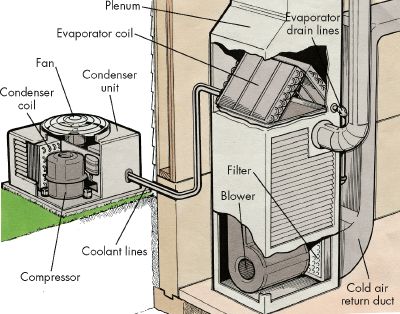|

|
|
Air
Conditioning

|
-
Air Conditioning and refrigeration are
provided through the removal of heat. The
definition of cold is the absence of heat and
all air conditioning systems work on this basic
principle. Heat can be removed through the
process of
radiation,
convection, and
conduction using mediums such as water, air,
ice, and chemicals referred to as refrigerants.
In order to remove heat from something, you
simply need to provide a medium that is colder
-- this is how all air conditioning and
refrigeration systems work.
-
-
An
air conditioning system, or a standalone
air conditioner, provides cooling,
ventilation, and humidity control for all or part of a
house or building. The Freon or other
refrigerant provides cooling through a process
called the
refrigeration cycle. The refrigeration cycle
consists of four essential elements to create a
cooling effect. A compressor provides
compression for the system. This compression
causes the cooling vapor to heat up. The
compressed vapor is then cooled by heat exchange
with the outside air, so that the vapor
condenses to a fluid, in the
condenser.
-
-
The fluid is then pumped to the
inside of the building, where it enters an
evaporator. In this evaporator, small spray
nozzles spray the cooling fluid into a chamber,
where the pressure drops and the fluid
evaporates. Since the evaporation absorbs heat
form the surroundings, the surroundings cool
off, and thus the
evaporator absorbs or adds heat to the
system. The vapor is then returned to the
compressor. A metering device acts as a
restriction in the system at the evaporator to
ensure that the heat being absorbed by the
system is absorbed at the proper rate.
-
-
Central, 'all-air' air conditioning systems
are often installed in modern residences,
offices, and public buildings, but are difficult
to retrofit (install in a building that was not
designed to receive it) because of the bulky air
ducts required. A duct system must be carefully
maintained to prevent the growth of
pathogenic
bacteria in the ducts. An alternative to
large ducts to carry the needed air to heat or
cool an area is the use of remote fan coils or
split systems. These systems, although most
often seen in residential applications, are
gaining popularity in small commercial
buildings. The remote coil is connected to a
remote condenser unit using piping instead of
ducts.
-
-
Dehumidification in an air conditioning
system is provided by the evaporator. Since the
evaporator operates at a temperature below
dew point, moisture is collected at the
evaporator. This moisture is collected at the
bottom of the evaporator in a condensate pan and
removed by piping it to a central drain or onto
the ground outside. A
dehumidifier is an air-conditioner-like
device that controls the humidity of a room or
building. They are often employed in basements
which have a higher
relative humidity because of their lower
temperature (and propensity for damp floors and
walls). In food retailing establishments, large
open chiller cabinets are highly effective at
dehumidifying the internal air. Conversely, a
humidifier increases the humidity of a
building.
-
-
Air-conditioned buildings often have sealed
windows, because open windows would disrupt the
attempts of the HVAC system to maintain constant
indoor air conditions.
Martin County: (772) 214-9929 Broward/Palm Beach Counties: (954) 340-6615
Email me at:
ev@magnuminspections.com
(Back to Top)
|
 |

